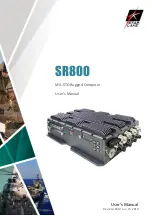
15
Instruction Booklet
IB02201004E
Effective October 2017
Revision #4
Instructions for installation, operation, and
maintenance of 38 kV type VacClad-W,
150 BIL switchgear indoor housings
EATON
www.eaton.com
Section 6: Inspection and maintenance
6.1 Safety precautions
Refer to the Safety precautions section of this manual .
WARNING
WHEN INSPECTING, REPAIRING, AND PERFORMING MAINTENANCE ON
SWITCHGEAR, THE FACT THAT DANGEROUS VOLTAGES MAY EXIST MUST
BE KEPT IN MIND. PRECAUTIONS MUST BE TAKEN TO ENSURE THAT
PERSONNEL DO NOT COME IN CONTACT WITH ENERGIZED HIGH VOLTAGE
PARTS. FAILURE TO DO SO COULD RESULT IN DEATH, PERSONAL INJURY,
OR PROPERTY DAMAGE.
Some common general precautions for high voltage work are:
Connections
All connections should be considered energized until the crew
expecting to work on them is ensured that the circuits are de-
energized, and until every possible precaution has been taken to see
that there is no chance of a circuit being energized while the crew is
working .
Switches
Switches, which have been opened to de-energize a circuit to permit
work on equipment, should be locked or blocked open, and a suit-
able visible warning device placed on them .
Grounding
Do not work on parts normally carrying current at high voltage until
these parts have been disconnected and grounded to the ground
bus . The purchaser should make provision for connecting adequate
flexible ground leads to every part of the switching equipment .
6.2 Access to switchgear parts
6.2.1 High voltage parts
VacClad-W switchgear is a metal-clad design . All major parts of the
primary circuit are isolated by grounded metal barriers and enclosed
within separate compartments . For example, the circuit breaker,
main bus, and primary line and load terminations are isolated from
each other and enclosed in separate compartments, which are made
from grounded metal barriers and covers . Access to high voltage
parts can be gained by removing the covers and barriers . The covers
and barriers should not be removed unless the parts to be exposed
are de-energized .
6.2.2 Main contacts
Stationary primary disconnecting contacts (spouts) are located
behind the automatic safety shutters in the breaker compartment .
Upper and/or lower spouts can be exposed by manually opening the
shutters (see Figures 10 and 11) . Do not expose any contacts unless
all upper and lower high voltage parts are de-energized .
WARNING
FAILURE TO DO SO COULD RESULT IN DEATH, PERSONAL INJURY, OR
PROPERTY DAMAGE.
6.2.3 Current transformers
Window type current transformers are installed over the stationary
primary disconnecting contacts (spouts) in the front of the unit (see
Figure 11) . All primary circuits must be de-energized prior to gaining
access to any current transformers .
WARNING
FAILURE TO DO SO COULD RESULT IN DEATH, PERSONAL INJURY, OR
PROPERTY DAMAGE.
6.2.4 Tranformers and primary fuses
A . Removing transformers from the auxiliary compartment and
replacing fuses:
1 . Follow the instructions in the Installation procedure section
of this manual, to remove the transformer drawer from the
auxiliary compartment . With the transformer(s) removed
from the unit, unscrew the contact spring retaining screws
(2) located at the end of the fuse tube . Remove the fuse
from the tube and replace with a new fuse . Reinstall the
contact spring on the new fuse and install the contact retain-
ing screws (see Figure 8) .
6.2.5 Control equipment
With the exception of apparatus such as current transformers and
rear-mounted heaters, control equipment and wiring is generally
accessible without exposing high voltage parts .
6.3 Inspection and maintenance schedule
To ensure high-quality service, a definite maintenance schedule,
systematically followed, is essential . Plant, operating, and local con-
ditions vary to such an extent that the schedule must be prepared
to suit the conditions . However, the following general requirements
should be helpful in setting up the program .
WARNING
BEFORE ATTEMPTING ANY INSPECTION OR MAINTENANCE, BE SURE
THAT ALL PRIMARY AND CONTROL CIRCUITS HAVE BEEN DE-ENERGIZED
AND GROUNDED AS REQUIRED, AND THAT PROPER STEPS HAVE BEEN
TAKEN TO BE SURE THAT THEY WILL REMAIN DE-ENERGIZED UNTIL ALL
WORK IS COMPLETED. FAILURE TO DO SO COULD RESULT IN BODILY
INJURY OR ELECTROCUTION. WHEN ENERGIZED, CIRCUIT CARRIES
LETHAL HIGH VOLTAGE.
6.3.1 Individual devices
The maintenance schedule for individual devices such as circuit
breakers, relays, and so on, should be based upon recommendations
contained in the individual instruction book for the device . These
operations should be coordinated with the overall program to result
in the least operating inconvenience and circuit shutdown .
6.3.2 Overall maintenance
The switchgear installation should be given a thorough overall
maintenance check at the end of the first year in service because
it provides an opportunity to evaluate conditions at an early point in
the life of the equipment . Where conditions are abnormal, more fre-
quent inspection and maintenance is necessary . Where conditions
warrant, a longer period of time between maintenance periods may
be used . The following require attention .
1 .
Buses and connections
De-energize the primary circuits and remove the cover plates
from the primary compartments . Before cleaning, take
megohmmeter (megger) readings between phases and each
phase to ground . Inspect for signs of overheating or weakened
insulation . Remove dust from buses, connections, supports, and
enclosure surfaces . A vacuum cleaner with a long nozzle will be
of assistance . Wipe clean with distilled water and wipe dry .
After buses have been dusted and wiped clean, take megger
readings again between phases and each phase to ground . Keep
a record of these readings for future reference in determining
when trends occur that would indicate a lowering of the insula-
tion resistance .
Periodic high-potential tests are not required after initial start-up
and are recommended only after repair of high voltage buses or
installation, or when the trend of megger readings indicates it to
be advisable . Refer to Table 1 .














































